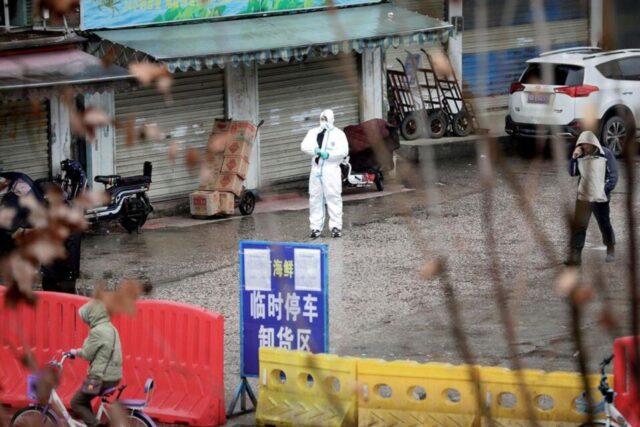OPINION: A new analysis by a team of international experts adds to evidence suggesting that the pandemic began when animals at the Huanan Seafood Market in Wuhan, China, spread the coronavirus to people. But there’s a problem: Other researchers can’t scrutinise the genetic sequences it’s based on, writes Amy Maxmen.
By Amy Maxmen
A NEW analysis by a team of international experts adds to evidence suggesting that the pandemic began when animals at the Huanan Seafood Market in Wuhan, China, spread the coronavirus to people. But there’s a problem: Other researchers can’t scrutinize the genetic sequences it’s based on.
This data needs to be made public. And if China won’t do it, then someone else must – either those who run the platform where the data was fleetingly available or the team that did the new analysis – even though, among scientists, releasing other people’s data is tantamount to theft.
This is an extraordinary situation. Anything that increases our understanding of how the world-shattering coronavirus pandemic started can help prevent the next one. Much is known, and so much more could be.
The data belongs to a group of Chinese scientists who did the hard work of swabbing surfaces at the market in January 2020 and recovering the genetic codes contained within. These researchers eventually put the sequences into an online data platform. They became public this January and were spotted by the international team earlier this month. When team members reached out to the Chinese scientists seeking to collaborate on an analysis of the data, all 665 gigabytes disappeared from view.
Chinese researchers have been sitting on this data for more than a year. On multiple occasions, their government has moved to obscure suggestions that the outbreak traces back to the trade in wild animals, or to Chinese laboratories. (The Chinese Center for Disease Control and Prevention did not respond to requests for comment.) This stands in contrast to the recent US law to declassify US intelligence on Covid’s origins.
The international team scrutinized the sequences during the brief time they were available, and posted a report online on March 20. Their analysis shows that some of the swabs from the market contain strings of genetic material from the coronavirus as well as from raccoon dogs, Malayan porcupines, hoary bamboo rats and other mammals sold for food and fur.
One sample contains the coronavirus plus thousands of sequences from raccoon dogs – and little to no sign of humans. This suggests that the creatures may have been infected. But deeper analyses of the data are still needed to determine if this is so. The alternative explanation is that the virus and raccoon dogs separately touched the same surface. Genetic sequences from a different set of market swabs contain human and coronavirus genes, indicating that people there carried the virus, too. This backs up earlier reports that the market was the epicentre of the outbreak.
Now the global public health community is in a pickle. Claims without verifiable evidence only inflame the furor over Covid’s origin. Virologists who aren’t involved with either team must analyse this data – as well as other genetic sequences described in 2022 by the same Chinese scientists but not posted.
The data could help answer key questions. For one, were mammals infected with the coronavirus being sold at the market? Researchers could scan the genetic sequences from animals for signs that immune system genes were turned on, ready to fight an infection.
Michael Worobey, an evolutionary virologist at the University of Arizona and an author on this week’s report, said the sequence data on raccoon dogs is so rich that further studies of it could also reveal where the creatures came from and whether they were trapped in the wild or farmed. That would inform efforts to curb future outbreaks.
Maria Van Kerkhove, the technical lead for Covid-19 at the World Health Organization, said she regularly asks researchers on the Chinese team to share the sequence data, but they are withholding it while their manuscript is reviewed for publication in Nature. (Until last July, I was a reporter for the news section of the journal, which is independent from the research section.)
There are three ways out of this bind. The best solution would be for the Chinese group to make public its data as soon as possible, whatever the status of their manuscript.
If that doesn’t happen, managers of GISAID, the non-profit platform hosting genetic data, could reveal the sequences from China retained on their private servers. Indeed, many researchers complain that this mess is the fault of the platform’s unclear policies around sharing and accessing critical data.
But such a move would betray GISAID’s vow to ensure that those who submit information maintain ownership of it. This promise is a key reason that scientists around the world have rapidly and voluntarily shared more than 15 million coronavirus genomes, enabling researchers everywhere to monitor the emergence of variants such as delta and omicron. If researchers stop trusting the platform, they may stop giving it data on SARS-CoV-2 and flu viruses, and the world would lose track of potentially dire threats.
Thus, the responsibility falls to the authors of this week’s report to reveal the sequences they downloaded, if China does not. These international scientists would risk losing access to GISAID for violating its rules. And because publishing someone else’s raw data runs afoul of ethical norms in science, they might be shunned by some colleagues. In other words, they would pay a price for China’s secrecy and GISAID’s flaws. Still, the data must come out.
This episode illustrates that, as world leaders consider how to prepare for the next pandemic, agreement on fit-for-purpose data sharing must be a top priority. Until that’s settled, scientists must help one another get to the bottom of covid’s origins.
* Amy Maxmen is an Edward R Murrow press fellow at the Council on Foreign Relations.
– THE WASHINGTON POST








